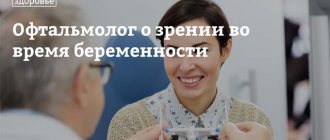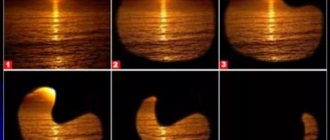Diagnostics
At the appointment, the woman should tell the doctor about her complaints and the peculiarities of the gestation period.
At the initial appointment, the doctor listens to the patient and finds out if there are any chronic diseases and how the pregnancy went. After this, the ophthalmologist conducts the following studies:
- Measuring intraocular pressure using a tonometer.
- Determining the clarity of vision of objects. An autorefractometer is used for this.
- Checking visual acuity using special tables.
- Examination of the cornea, lens and iris.
- Blood pressure measurement.
In case of retinal detachment or after laser vision correction, before or during pregnancy, the woman in labor must undergo a cesarean section.
How do pregnancy and childbirth affect a woman's vision?
Due to the restructuring of the hormonal background of the expectant mother and for the successful course of pregnancy and childbirth, the structure of the eyes and eye muscles undergoes changes:
- Fluid accumulates in the lens, causing it to change its size. As a result, the passage of the light beam becomes difficult.
- The cornea and sclera change viscosity, which leads to the appearance or worsening of myopia.
- The eye ligaments relax; this occurs closer to childbirth and is associated with the body’s preparation for childbirth.
Various pregnancy pathologies are not taken into account. In some cases, the changes become so dangerous that doctors decide to perform an emergency caesarean section.
If you vomit during toxicosis more than ten times a day, vascular ruptures are possible, which lead to severe internal hemorrhage. Preeclampsia is also potentially very dangerous for the condition of the ocular apparatus. It is characterized by a deterioration in blood circulation in the capillaries, which is accompanied by changes in blood pressure. Sometimes this condition leads to rupture of blood vessels, partial detachment of the retina and blockage of capillaries.
Childbirth itself also affects vision. However, it is more pronounced if the pregnant woman already had problems or had high blood pressure. When trying, rupture of retinal capillaries, its detachment, and thrombosis is possible.
Treatment methods
After the examination, treatment is carried out, taking into account that during this period the woman is breastfeeding the child. If vision has become worse due to primary diseases, therapy is prescribed by a specialized specialist, but in most cases the condition does not require intervention. Key ways to eliminate vision problems after childbirth are presented in the table:
| Pathology | Peculiarities |
| Dry eyes | Prescribe special moisturizing eye ointments and drops |
| Blurry or unclear vision | If the problem is caused by thickening of the cornea due to fluid retention, no measures are taken; in some cases, glasses are selected |
| Visual impairment due to gestational diabetes | Increased blood glucose levels during pregnancy may affect the eyes |
| Therapy is carried out by an endocrinologist |
Causes
But the condition of a woman’s visual organs is affected not only by childbirth, but also by pregnancy itself:
- Changes in the amount of hormones that affect the condition of the muscles inside and outside the eye, cornea, and retina. Overstrain of the intraocular muscles may occur, which leads to constant eye fatigue.
- Accumulation of excessive fluid inside the lens due to increased metabolism. This increases its curvature, so the light beam is projected incorrectly on the retina.
- Changes in the internal composition of the cornea and vitreous, which worsens myopia. The light beam is not refracted correctly in them, which leads to a projection not on the retina, but in front of it.
- For normal delivery, all the muscles of the body are weakened. This is necessary for the baby to pass through the birth canal. The inside and outside of the eyeballs also contain muscle tissue, which leads to changes in the structure of the oculomotor system.
- If pregnancy was accompanied by severe toxicosis in the first trimester and gestosis in the last stages, intraocular pressure increases. The chambers of the eye expand, which causes compression of the retina and optic nerve.
During childbirth, the structure of the tissues inside the eyeballs in the surrounding space changes.
If pregnancy was accompanied by pathologies, for example, gestosis, high blood pressure, thrombosis, the risk of the following pathologies during labor increases:
- retinal tear;
- rupture of microcirculation vessels, leading to intraocular bleeding;
- blockage of microcirculation vessels by a thrombus, which leads to temporary or permanent blindness, atrophy of the eyeball;
- tension of the eye muscles, leading to a temporary decrease in visual acuity.
If a woman pushes excessively during childbirth, afterward hemorrhages will be detected on the outer surfaces of the eyes. Over time they will resolve.
After childbirth, a woman’s hormonal levels are partially normalized. But if she chooses to breastfeed, some hormones do change. This causes a partial decrease in visual acuity, which occurs for the following reasons:
- previous gestosis in the prenatal period;
- high blood pressure that persists for the period after childbirth;
- complications of myopia that existed in the patient before conception, which worsened during the birth process;
- prolonged labor, especially if the period of pushing has been exceeded;
- large blood loss due to rupture of the uterus and birth canal;
- complications from diabetes mellitus caused by blockage of blood vessels in the eye microcirculation with glucose conglomerates;
- inflammatory processes of the retina caused by the spread of a viral infection (herpes, toxoplasmosis) due to pregnancy.
An additional negative factor after childbirth is that the woman spends most of her time at home caring for the baby. This limits the field of vision for the eyes. Focusing on nearby objects occurs, which strains the organs of vision. Therefore, in order to restore eye function after childbirth, it is recommended to walk for a long time in open space.
Prevention
Daily walks will help restore eye function.
In addition to the prescriptions of an ophthalmologist, performing special eye exercises, proper nutrition, a healthy lifestyle and folk recipes for visual acuity will help restore vision if it has diminished after childbirth. Long walks in the fresh air and giving up bad habits are helpful.
Vitamin complexes
Carrying a child depletes a woman’s body, so for recovery she needs vitamins that help strengthen all organs, including visual ones. The following vitamins are recommended for young mothers:
- A. Lack of retinol significantly impairs vision. Essential not only for the eyes, but also for the skin, teeth and hair.
- B1. Thiamine helps restore the nervous system.
- B6. Pyridoxine improves the condition of muscles, including the eye muscles, and increases the level of hemoglobin in the blood.
- B9. Folic acid takes part in cell regeneration.
- C. During the postpartum period, ascorbic acid increases the body's defenses.
- E. Tocopherol helps strengthen the eye muscles, tooth enamel, and improves heart function.
- PP. Nicotinic acid regulates the blood supply to organs.
With the help of dairy products, a woman can replenish her supply of vitamins.
To get the necessary vitamins, it is recommended to consume foods such as:
- soft and hard cheeses;
- avocado;
- fatty sea fish;
- dairy products;
- eggs;
- fresh vegetables, herbs;
- berries;
- beef or pork liver.
Folk recipes
- Wild garlic juice. If the blood vessels become red, wash the eyes with a solution of juice and water in a ratio of 50:50.
- Mint. Infusions of the plant are used in the form of lotions; the following composition is instilled into the eyes: 100 ml of water and a drop of mint oil.
- Rose hip. Brew 2-3 tablespoons of the plant’s fruits in a thermos with two liters of boiling water and leave for about 8 hours. It is recommended to take a glass of infusion throughout the day. Indicated for retinal dystrophy.
- Carrot. Pass several root vegetables through a juicer, drink 100 ml twice a day.
- Bulb onions. Add fresh to salads or sandwiches.
- Blueberries, cranberries, lingonberries. They recommend eating berries and squeezing fresh juices. Drink 250 g twice a day. Helps strengthen vision.
- Saffron. Natural antioxidant, source of lutein. Add to dishes to restore retinal function.
Exercises
Closing your eyes with your hands for a few seconds is considered a useful exercise.
You can do eye exercises at any convenient time. Lessons last 4-6 minutes. significantly help improve vision:
- Draw a dot on the window glass, alternately look at it and at the most distant object outside the window.
- Close your eyes tightly, count to 5, and open them. Repeat several times.
- Cover your eyes with your palms, without pressing on the eyelids and eyeballs. After 4-6 seconds. remove your palms. Perform 6-8 times during the month.
- Sitting and holding your head straight, rotate only your eyeballs. Draw any numbers mentally.
- Close your eyelids and lightly massage them in the direction from the outer corner of the eye to the bridge of the nose and back.
You need to take care of your vision before and during pregnancy. Don't put too much strain on your eyes. You need to eat healthy foods in sufficient quantities and avoid emotional overload. Timely consultations with a doctor and examinations by an ophthalmologist will help prevent discomfort after childbirth, and sometimes avoid severe pathologies.
Does vision always decrease after childbirth?
Often on mother's forums there are glaring questions: vision loss after childbirth - what is this and why??? The panic of a new mother is understandable, but not always appropriate. During pregnancy, every woman is required to undergo an examination by an ophthalmologist, and this is not an unnecessary “obligation”, but an important necessity. During this crucial period, colossal changes occur in the body, and not only at the hormonal level, but also metabolism changes dramatically. Plus, the development of the fetus is accompanied by a decrease in the reserves of nutrients in the female body, and if they are not replenished, many organs will be seriously damaged.
All these processes can also affect the eye apparatus, which will affect visual acuity already during the period of bearing the baby or immediately after childbirth. That is why it is necessary to visit an ophthalmologist in every trimester of pregnancy to avoid complications with the eyes in the postpartum period. If serious degenerative changes are detected in the eyeball, natural childbirth may be strictly contraindicated, and the baby will be born by cesarean section. Women who have serious eye diseases are sometimes not even allowed by doctors to become pregnant.
It often happens that there were no problems with vision throughout pregnancy, but after childbirth it sharply worsened. The most common cause of this condition is increased physical stress during labor, when the oculomotor muscles “participate” in childbirth, especially with incorrect attempts (the woman in labor often strains not only the necessary muscles of the abdomen and pelvis, but the whole body). With this course, intraocular pressure may increase, even hemorrhage may occur, and temporary strabismus may occur after childbirth. Often they leave the delivery room with swollen red eyes, and even with poor visual sharpness.
Doctors reassure: after childbirth, vision can deteriorate by just one diopter, and they call this “pathology” a physiological decrease in vision (primarily due to changes in the pregnant body).











